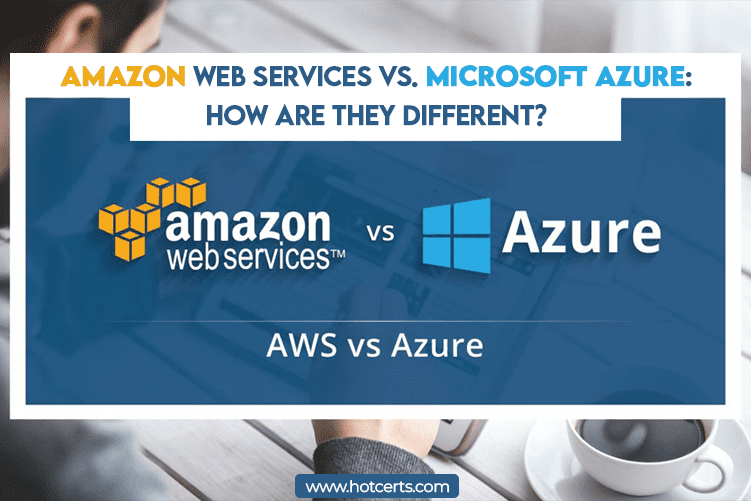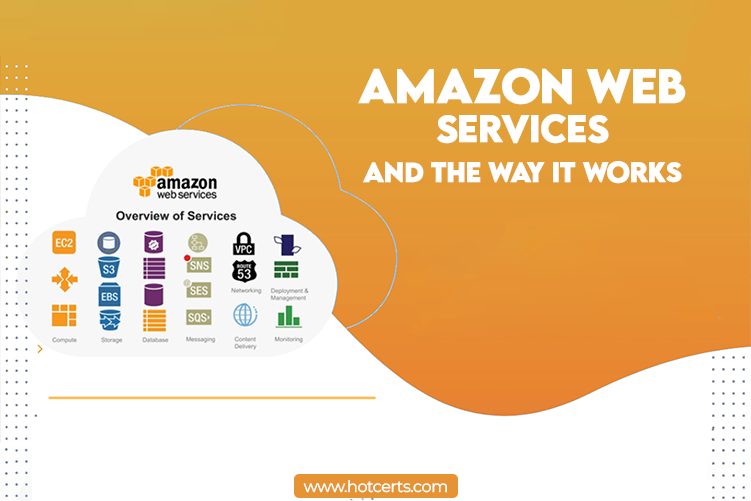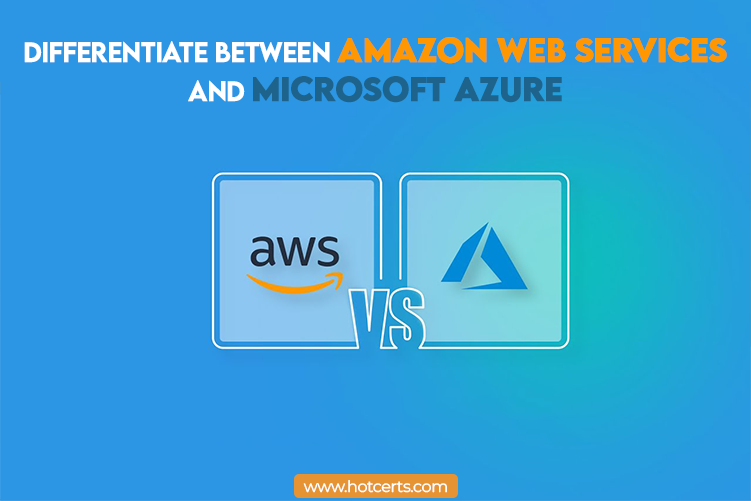Amazon Web Services vs. Microsoft Azure: How are they different?
Microsoft Azure and The Way It Works
Microsoft Azure was previously known as Windows Azure. Microsoft’s public cloud computing platform offers various cloud services such as storage, computing, analytics, and networking. Users can pick from these services to create and scale new applications or operate existing applications in the public cloud. The Azure Platform is intended to help companies manage their challenges and achieve their organizational goals.
It provides tools to support all industries, including e-commerce, finance, and various Fortune 500 companies, and is compatible with open-source technology. Microsoft Azure offers users the flexibility to operate the tools and technologies they desire. Customers can access all services incorporated in the Azure portal when they subscribe to Azure. Subscribers build cloud-based resources like virtual machines (VMs) and databases from these services. In addition to Microsoft’s services through the Azure portal, many third-party vendors make their software directly available through Azure.
Billings for third-party applications vary widely, but you may have to pay for the usage of the Infrastructure used to host your application on top of the application’s subscription fee. Microsoft offers five customer support options for Azure: basic, developer, standard, professional direct, and premier. These customer support plans range in content and expense. Critical support is available for all Azure accounts, but Microsoft charges for other support services.
Amazon Web Services and the way it works
Amazon Web Services or AWS is an extensive and evolving offering from Amazon that includes a combination of Platform as a Service, Infrastructure as a Service, and Packaged Software as a Service. A cloud computing platform that Amazon web services can provide organizational tools such as computing power, database storage, and content delivery services. It was established from the internal Infrastructure built by Amazon to handle its online retail business in 2006.
Amazon web services were one of the first companies to present a pay-as-you-go cloud computing model that mounts to provide users with storage, computing, or throughput. Amazon web services deliver various tools and solutions for businesses and software developers to use in data centers in up to 190 countries. Amazon web services are divided into multiple services, and one can configure each in different ways based on user needs. The user should be able to view AWS service configuration options and individual server maps.
More than 100 services incorporate theAmazon web services portfolio, including computing, infrastructure management, application development, databases, and security. These services include safety, database, migration, computing, storage, development tools, AI, data management, hybrid cloud, governance, messages and notifications, networking, management, monitoring, extensive data management, analysis, and mobile development.
How are these two different from one another?
Azure and AWS offer similar capabilities to customers, and both cloud offerings are comprehensive. Users can host various applications, learn about cloud services, use AI and ML, and benefit from open-source contributions. However, some key differences remain, mainly in the pricing model and documentation approach. Most Azure adopters are affected by the availability of the larger Microsoft ecosystem, which includes various productivity tools, business apps, and Windows. On the other hand, Amazon’s web service is more affordable and often suitable for first-time adopters.
1. A significant problem in computing is scalability. Amazon web service employs Elastic Cloud Computing (EC2) to give a discourse to this. With EC2, the available resource footprint can grow or shrink on demand due to elastic cloud computing resource provisioning. A local cluster provides a portion of the resource pool that all processes can access simultaneously.nEC2 users can build virtual machines (VMs), select pre-configured machine images (MIs), change MIs, and change the necessary power, size, and memory of a VM.
You can also choose the number of virtual machines you want. On the other hand, Azure users are provided with the option to form a VM from a virtual hard disk (VHD). Use virtual scale sets to offer scalability and enable load balancing. The main difference is that EC2 can be customized for different use cases, while Azure VMs work with other cloud deployment tools.
2. Providing Cloud Storage A successful cloud deployment depends on having adequate storage. Azure and AWS have roughly equal strengths in this regard, but their offerings differ. AWS has services such as Amazon Simple Storage Service (S3), Elastic Block Store (EBS), and Glacier, while Azure storage services offer blob storage, disk storage, and standard archive.
AWS S3 gives customers a safe, scalable, and robust storage solution for unstructured and structured data subjects. Comparatively, Azure proposes data storage in Azure Blogs, Azure Disks, Azure Tables, Azure Queues, and Azure Files. Both allow an infinite number of objects. However, Amazon web service has an object size limit of 5 TB, while Azure has a limit of 4.75 TB.
3. AWS does a great job of choosing secure alternatives and settings by default to ensure enhanced privacy, whereas Azure uses Microsoft’s Cloud Defender service for security and data privacy. It is an artificial intelligence-powered solution that protects against emerging threats. However, Azure services, such as virtual machine instances deployed with all ports open, are not 100% secure by default unless otherwise configured.
4. Azure and AWS free customers from dealing with licensing headaches and license mobility issues. Both follow a pay-as-you-go pricing structure, meaning customers only pay for their services. If they have paid for benefits before, they are eligible for License Mobility in Microsoft Azure. Azure is less complicated to set up for Windows administrators, while Amazon web services are more configurable and feature-rich.
Comparing Amazon’s web service and Azure, it is clear that most services are the same on both platforms. On the other hand, Azure has more software-as-a-service (SaaS) capabilities than AWS. Microsoft includes SaaS offerings such as Azure Visual Studio Online, Azure Scheduler, Azure Site Recovery, and Azure Event Hubs. But AWS appears to be ruling regarding flexibility and adaptability to the open source community and revenue generation.
5. Finding a secure and isolated network is essential for cloud users, and network performance is a crucial parameter for cloud solutions. Both Amazon web services and Azure have their perspectives on creating isolated networks. Users can employ the cloud to develop isolated private networks using AWS Virtual Private Clouds (VPCs). Application programming interface (API) gateways are used for cross-premises connectivity.
During network connectivity, use elastic load balancing to ensure smooth operation. Within a VPC, users have many possibilities to create private IP ranges, route tables, network gateways, etc. By comparison, Azure leverages virtual networks rather than VPCs. AWS and Microsoft Azure provide cloud-compatible firewall alternatives to extend your on-premises data center to the cloud without compromising your data or business processes.
6. Modeling Both AWS and Azure have machine learning studios for machine learning (ML) model development. Coding and data science skills are required to use AWS artificial intelligence (AI) tools. SageMaker on AWS gives you complete freedom and flexibility in creating ML models. Users should be familiar with Jupiter Notebooks and have an expert level of Python to implement their ideas and take full advantage of Amazon web services features. SageMaker is ideal for developers with experience, coding knowledge, and robust data engineering expertise.
Comparatively, Azure ML Studio is mainly focused on delivering codeless knowledge. Its interface features easy drag-and-drop pieces that enable users to build comprehensive ML models with little programming knowledge. You do not require to learn Python or be an expert in advanced data science techniques to participate.
This service is aimed at data analysts who prefer a simple interface and visual presentation of elements. Artifacts and resources are kept in the same bucket and systematized in different folders. Everything is integrated into Azure. Artifacts connected to the same model launch are often placed in diverse locations, making them challenging to find and investigate.
7. SageMaker logs model metrics and historical data through CloudWatch, which transforms the data into a functional format and includes the data for 15 months. Additionally, you can track the behavior of your model and make changes or updates as needed.
Azure ML Studio uses MLFlow for data monitoring and recording. The visual presentation and graphic features make the overall procedure very intuitive. Autolog can be set for convenient logging, eliminating the need to log statements explicitly. If you compare the two systems, the Azure mechanism is superior in terms of usability and data presentation.
8. These two solutions offer a wide range of database services for processing structured and unstructured information or big data. Amazon web services users can use Amazon RDS regarding data management durability, while Azure has an Azure SQL Server database option.
RDS is consistent with six database engines: MariaDB, MySQL, Microsoft SQL, Amazon Aurora, and PostgreSQL. Regarding Azure, SQL Server database solutions are based exclusively on Microsoft SQL. In terms of interface, Azure has a more accessible and smoother interface, while AWS offers better provisioning and more instances.
These services are roughly comparable in reach and offer analytics and extensive data capabilities. Similarly, Amazon web services have Elastic MapReduce (EMR), and Azure has HD Insights. Additionally, Azure users have access to the Cortana Intelligence Suite covering Spark, Hadoop, HBase, and Storm.
Amazon web services offer a relatively mature environment for big data processing compared to Azure. Both of these systems are compatible with NoSQL and relational databases. They are widely available, have a long lifespan, and offer simple automated replication. AWS offers additional instance types, but Azure’s tools and interfaces are straightforward, making it easy to complete many database operations.
9. AWS is Linux-compatible and offers many integrations for various open-source applications, making it a good choice for open-source developers. In contrast, Azure allows users to leverage their existing Active Directory accounts to sign on to Azure and run apps based on the .net framework in Linux, Windows, and macOS environments where .net and Linux are essential.
Microsoft Azure is still on the long road to adopting the open source community, contributing to Amazon web services dominance in the open source cloud hosting space.
10. One of the benefits of cloud providers is the ease of deploying applications. Users in the developer role may wish to leverage the Platform as a Service (PaaS) capabilities to virtually distribute their applications across multiple servers. To sustain this, Azure proposes various app deployment options, including container services, cloud services, functions, and batch and app services. Amazon web services like Elastic Beanstalk, Batch, Lambda, and containers have capabilities. But it lacks some elements when it comes to app hosting. For example, Azure protects intellectual property and improves the processing of backend data streams.
11. AWS offers several container services for use cases such as IoT, mobile application development, and desktop computing environment development and also provides native Docker support for containerization. Microsoft is on par with Amazon web services in this area and offers Hadoop support through Azure HDInsight so that it could go even further. Both Windows and Hyper-V containers can be integrated with Docker in Azure using Windows Server 2016. Windows or Linux containers can also run on the Platform.
Containerized apps on AWS run using Elastic Beanstalk, which supports Docker files through a command line interface. zureApp Service in A performs this functionality, but the procedure is a little more complex as you need to run a container inside your web app.
12. For the first quarter of 2021, Amazon reported revenue of $13.5 billion. It exceeded the $13.1 billion forecast by experts. That is higher than the foremost quarter of 2020, when AWS posted $10.33 billion in revenue. AWS revenue for the quarter was up 32% from 28% last quarter. Amazon web services revenue accounted for approximately 12% of Amazon’s total revenue for the quarter and about 47% of Amazon’s overall operating profit. AWS’s growing profitability is a crucial driver of Amazon’s growth.
Amazon discloses revenue for AWS, while Microsoft discloses growth for Azure. The boosted last-quarter revenue by 50% in Q2 2021, outperforming analysts’ forecast of 46% growth. The growth rate for this time last year was 59%. However, Microsoft provides revenue data from the “Intelligence Cloud” division to which Azure belongs. Revenue increased 23% to $15.1 billion. Server products and cloud services, also included in the quarterly report’s functional group, saw 26% growth.
13. Both AWS and Azure offer reasonable pricing and pay-as-you-go pricing models. Both provide free deployment packages to show users how to integrate the system with on-premises software. AWS is billed hourly, and instances are available for purchase. Azure, on the other hand, is billed by the minute. It means users can benefit from more accurate pricing components than AWS. You can also enter short-term contracts and choose between prepaid or monthly fees. Azure short-term subscription plans give you more flexibility.
Microsoft Azure pricing with BT MPLS ExpressRoute is also available, turning your company’s private network into the cloud with the right features. However, when comparing the two, Azure typically turns out to be the more expensive option, potentially increasing cloud costs for enterprises. It can be demonstrated with Azure instances where the price increases as the size increases. Azure costs almost twice as much as Amazon web services for a 256GB RAM and 64vPCU configuration.




